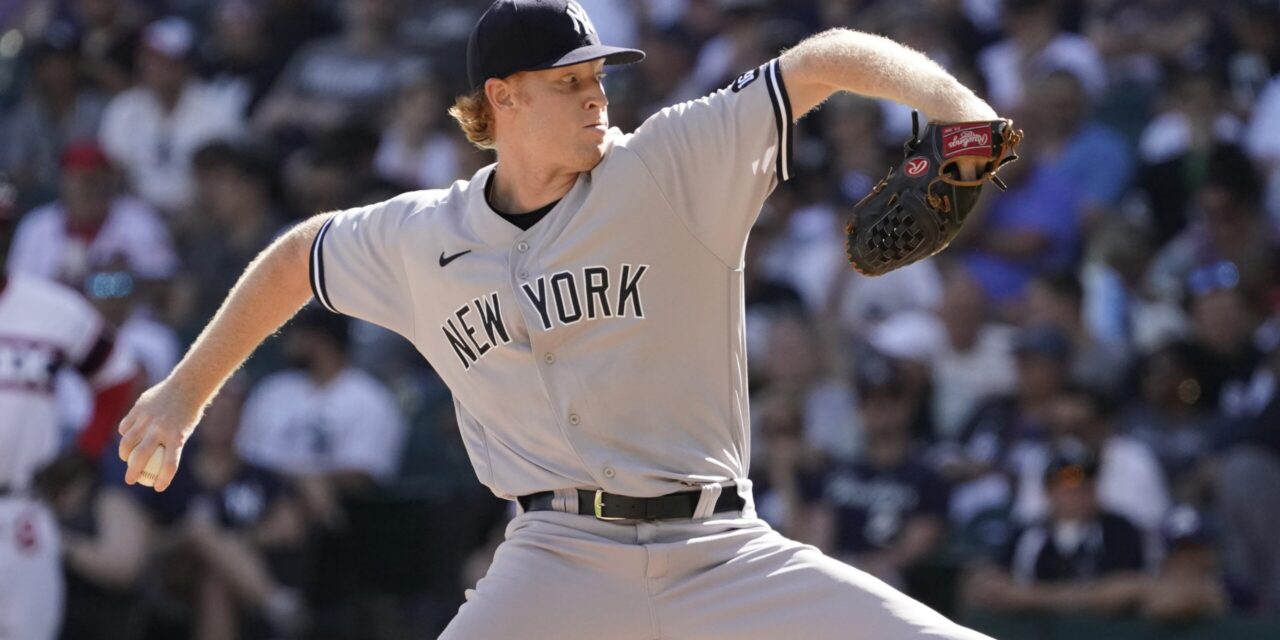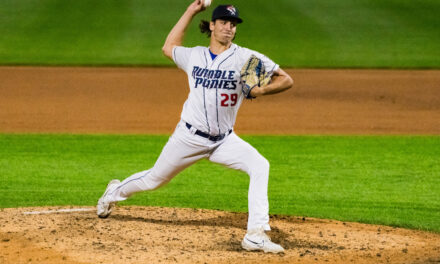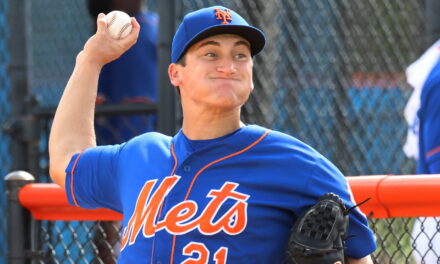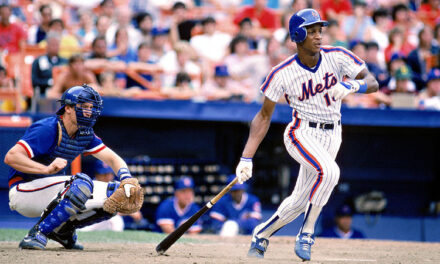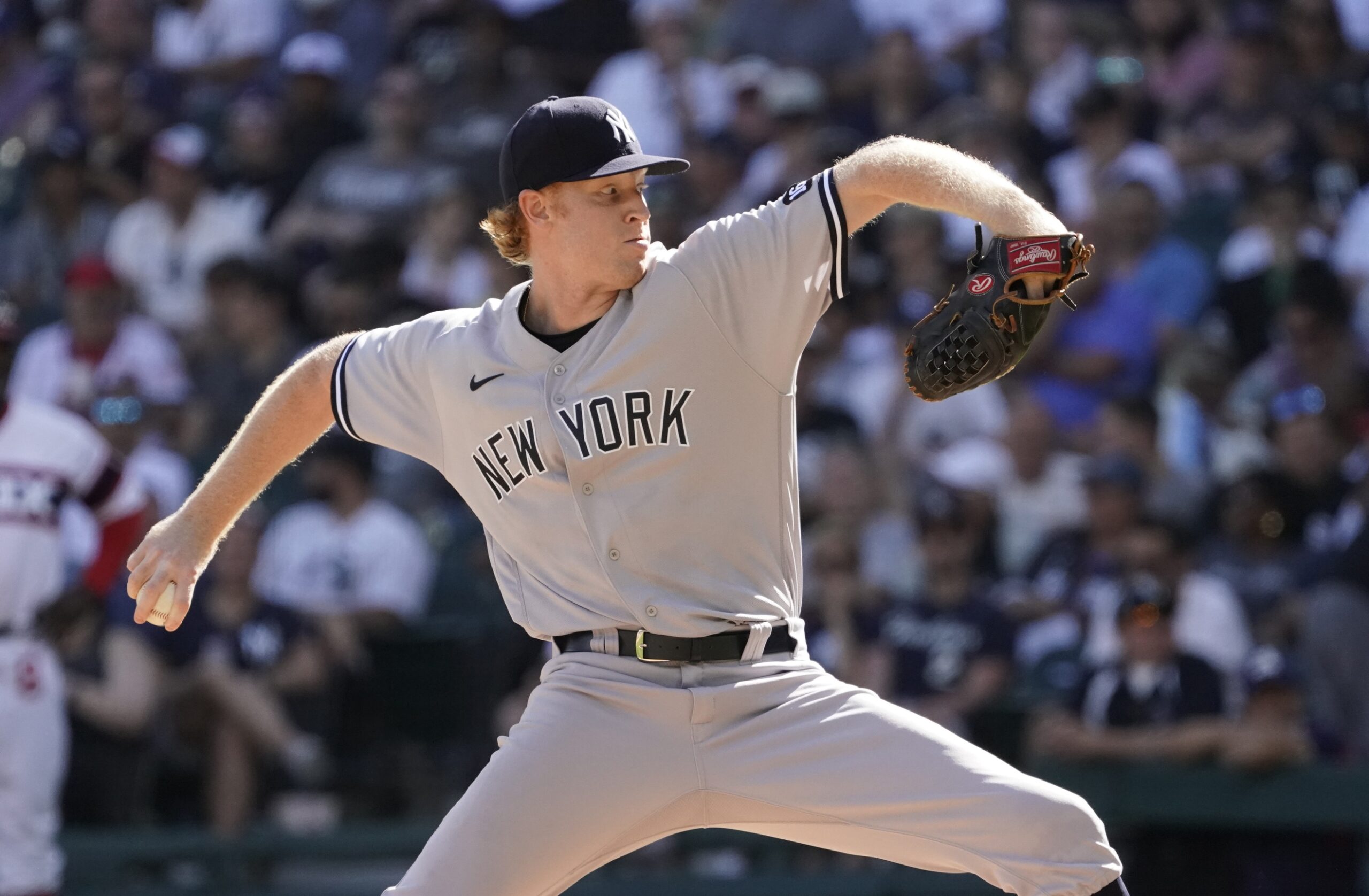
Mandatory Credit: David Banks-USA TODAY Sports
Following the conclusion of the 2022 season, the New York Mets’ bullpen was going to be potentially very different heading into the 2023 season.
For all of the rightful chatter regarding whether the Mets were going to re-sign Jacob deGrom, Chris Bassitt, Brandon Nimmo and Edwin Díaz (which they did the first day of free agency), the majority of the Mets pen was set to hit the open market.
As the team looks to rebuild its pen for the ’23 season, the Mets claimed an intriguing arm off waivers from the New York Yankees in mid-November. With clubs facing roster squeezes prior to the 40-man roster deadline in order to protect prospects from the Rule 5 Draft in December, the Mets had several spots available to take advantage of other teams’ roster crunches.
Long Island native and hard-throwing right-handed reliever Stephen Ridings is that intriguing arm who the Mets hope can be a potential option out of the pen.
Ridings, 27, was an eighth-round pick by the Chicago Cubs in the 2016 MLB Draft out of Haverford College in Pennsylvania.
After undergoing Tommy John surgery early in his minor league career, Ridings had his breakout season in 2021 with the Yankees after he signed a minor league deal with the team before the start of the season.
In 22 appearances out of the pen for the Yankees’ Double-A and Triple-A affiliates, Ridings posted a career best 1.24 ERA and 0.690 WHIP, and struck out 42 of the 110 batters he faced (38.2 K%).
That same season, Ridings made his major league debut on August 3 in front of family and friends in the Bronx. The six-foot-eight righty tossed a scoreless inning against the Baltimore Orioles in the seventh, recording all three outs via strikeout.
Of the sixteen pitches Ridings threw in his scoreless inning, two were clocked at 100+ mph and 11 were 97+ mph.
Overall, Ridings made five appearances for the Yankees in the month of August, posting a 1.80 ERA with seven strikeouts to two walks over five innings pitched.
Unfortunately for Ridings, the 2022 season would not be one in which he built off his ’21 success. A lower back injury, shoulder injury and nerve-related complication kept Ridings off the mound except for two late rehab appearances in September.
This offseason, Ridings is continuing a throwing program to strengthen his arm and build the velocity back to his fastball and slider. He’s optimistic on his fastball velocity, as he was sitting 97-99 mph in his rehab outings.
For the Mets, the addition of Ridings provides them with an optionable arm (with all three of his minor league options remaining), that gives them flexibility with their roster construction.
I had the privilege of speaking with Ridings where he discussed when the triple-digit velocity materialized, the injuries he dealt with in 2022 and joining the Mets.
MMO: Who were some of your favorite players growing up?
Ridings: I’ve got to be honest, I didn’t watch a ton of baseball growing up. I’m from Long Island, so I knew the Mets and Yankees. I probably didn’t have favorite players until maybe high school or college.
I always looked up to guys like [Jacob] deGrom and [Noah] Syndergaard; pretty much anybody that threw hard. I was a big fan of the old Josh Beckett. Those were probably my upper-tier guys.
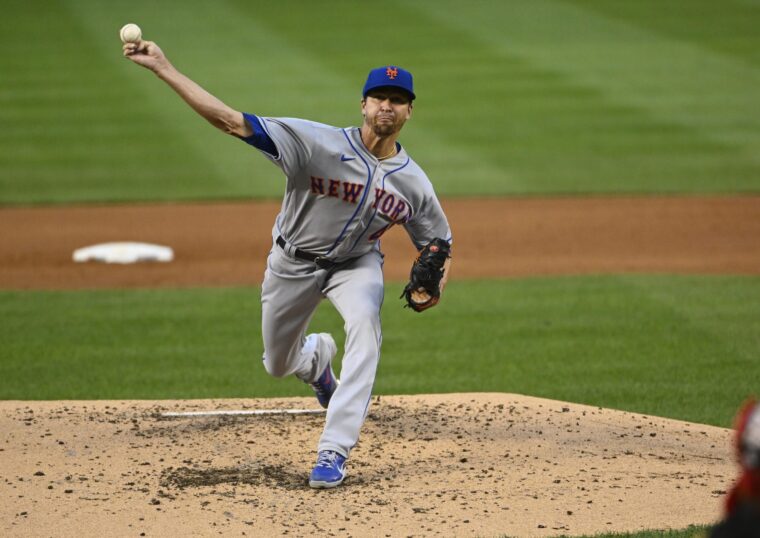
Brad Mills-USA TODAY Sports
MMO: Did you play other sports besides baseball?
Ridings: I played basketball and volleyball.
MMO: Considering your height, did you get any collegiate offers for basketball?
Ridings: No. Although I did get attempted to be recruited out of our college intramural early if that counts for anything. [Laughs.]
MMO: At what point during your development did you start focusing primarily on pitching?
Ridings: I always enjoyed pitching. I would say I became more of a pitcher only right around my junior year of high school.
Obviously, on the travel ball teams, everybody plays every position. When it got a little more competitive that took a back seat. I did not get recruited as a two-way player in college.
MMO: When you made your major league debut in 2021, you hit triple-digits on the radar gun. Do you remember when that kind of velocity started to come into play?
Ridings: Yeah, it was January 6, 2021, the day I got signed by the Yankees. It was kind of out of nowhere. I touched 98 once in college; I had been up to 96 pretty consistently but never averaging anywhere close to [triple-digits].
At the beginning of my minor league career, I had Tommy John [surgery] and the velo dipped a lot. It came back a little bit in 2019 but it still wasn’t where it was now. After I got released it just showed up one day and stuck around.
MMO: Do you have any idea of how you might’ve increased your velocity?
Ridings: I put on a few pounds, we cleaned up some things mechanically, and started doing a lot of medicine ball work. There’s not really one thing that I can contribute it to.
I get asked that question all the time and I don’t know the answer. I’d like to think the velo has always been in the arm and it’s just about putting it all together as a tall, lanky individual.
MMO: What are your memories from the 2016 Draft? Did you have an idea that the Cubs could be a potential landing spot?
Ridings: I had a feeling they were going to be the one. I had heard from most teams; there may have been a handful that I didn’t have any communication with whatsoever. But nobody really gave me any indication as to where I may fall on Draft day.
I knew a couple of people who had some friends in either the scouting department or front office [for the Cubs]. I knew they were probably one of the more well-represented teams in terms of who would come see me the most. I had a good feeling they would be up there.
MMO: I read an article on Major League Baseball’s website that you were a substitute teacher in Florida for several months from 2020 to 2021. Can you talk about how that came about, and some of your responsibilities during that period?
Ridings: It was the first real offseason that I wasn’t going back to school at all. I finally moved down here (Florida) with my fiancée full time, and she was like, “You’ve got to get a job in the offseason. You can’t just work out and do nothing.”
I basically applied to anything and everything I could find on Indeed and all the job recruiting sites. Eventually, Rawlings and the school I was at reached out and said they could use some help.
My responsibilities as a sub were basically show up, take attendance and enforce the rules they had during the Covid period. It wasn’t really any teaching.
I don’t remember the article exactly, but it wasn’t a specific chemistry substitute teaching gig like I know some people have made it out to be. It was what you’d expect out of a substitute teacher: show up, hand out the work, sit there at the front desk and make sure kids don’t get too rowdy. I felt it was more of a babysitting gig than anything.
MMO: Is it true that you ended up signing with the Yankees because you worked out at Eric Cressey’s (Yankees’ Director of Player Health and Performance) gym in Florida during that same time?
Ridings: Yes. I started working out at Cressey’s in the offseason of 2019. Heading into 2020 and the Covid year, I spent all summer working out there. I’m still there to this day in the offseason.
He put out the word to one of his scouts. I think in my second bullpen I was throwing maybe 94-95 mph. He was like, “That’s pretty good for your second time. I’ll get one of the scouts down here to see you.”
I heard nothing the whole week and then the next bullpen rolls around and he said, “Yeah, he’ll (the scout) will be here.”
And then out of nowhere, I was 97-100 [mph], and they signed me about an hour later. It was a wild turnaround.
MMO: You were used a starter with the Royals organization in 2019, and then switched to the pen with the Yankees. Were there any adjustments to that transition?
Ridings: Not at first. I would say there was more of an adjustment when I got called up to the big leagues, just because it’s the big leagues and you’ve got to be ready at all moments.
Things were more or less structured in the minor leagues with the Yankees for that 2021 year. I would have a solid idea of when I was throwing or what kind of situation I’d be going in for. Then you’d throw and get one-two-three days off: rinse and repeat. It became pretty routine.
The transition initially wasn’t very hard but learning to find sustainable routines in the big leagues has been taking up more of my thought lately than anything else.
MMO: One of the main adjustments you made was cutting down your walks from 2019 to 2021. You went from an 11.5% walk rate in 2019, to 3.6% in 2021. Was there anything you worked on or altered to see such a big change?
Ridings: I chalk it up to the increase in velo and the timing of everything. I’m a big believer that if I have the ability to sync everything up and throw that hard, I’ll be able to put the ball in the zone. It means things are timed up right and I’m in a good spot.
People chalk it up to throwing 100 and having the confidence not to nibble, and that certainly plays a role.
MMO: You had quite the big-league debut with a scoreless inning with three punch-outs against the Baltimore Orioles on August 3, 2021. What memories do you have from that day and game?
Ridings: That was an emotional day. I was supposed to be going home for a funeral; my grandmother had just died the day before.
I got the call the next day and they said, “We know you have plans to go home, but we’re going to throw a wrench in those plans. We need you to come up to New York.”
I remember calling my fiancée and she was freaking out because she couldn’t find a flight. I called my parents and they were literally walking out of a funeral home. They were like, “Hey, not the best time, Stephen. What’s up?” I told them I was going to the Bronx that night. I never heard my dad make noises like he did at that moment. [Laughs.] That sticks in my brain visibly.
I remember getting there pretty much two hours late because they didn’t tell me until two in the afternoon. I missed stretch and missed throw. I got there and everyone was out taking BP, so I grabbed anybody who was willing to throw with me during BP and played catch in the outfield.
I remember not being able to eat my pregame meal. I was super excited but super nervous. Brett Gardner came over and sat next to me and said, “Hey, man, you’re not going to eat any of this food?” I was like, ‘Heck no! I’m pretty nervous right now.’
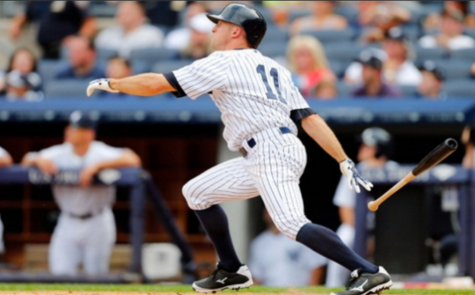
I had no idea whether or not I was going in the game. I was looking at the other guy who came up with me, Brody Koerner, at one point and we’re up about 7-0. I said, ‘Dude, we might be going in this game.’
They called down to the bullpen and I’m sitting pretty much right next to Mike Harkey, the bullpen coach, and everybody’s looking at him like who’s going in the game. He said, “It’s going to be this guy sitting right next to me.”
It took me probably a good ten seconds for it to sink in that he was talking about me. I looked down at the rest of the bench and they were all staring at me. I was like, “Oh, crap, it’s me!’ [Laughs.]
I frantically got up and started throwing balls in the pen. I got out there, waited to find that first strike and then it was smooth sailing.
It was a crazy turnaround. My mom almost didn’t come to the game, she was like, “We have a lot on our plate, Stephen.” They were thinking maybe now wasn’t the best time and didn’t know if I was going to pitch. It was my fiancée who texted my mom and said you have to go to this game; he could pitch and you’d miss it. Thankfully she came.
I ended up having a bunch of other friends in the stands that I didn’t even know were going to be there. It was nice to see the support after the game. It was a wild twenty-four hours for sure.
MMO: Unfortunately, you dealt with a tough 2022 season where injuries interrupted what you did in 2021. I know you were listed with having a right shoulder impingement, but after reading some articles it seems like there might have been other stuff at play. Can you talk about what you dealt with this past season and the rehab process?
Ridings: It kind of started with a lower back injury in January that we really couldn’t get a grasp on. With the lockout, it was kind of tough to navigate that.
It was weird because I was still working out at Cressey’s place, but I wasn’t allowed to communicate with him at all. Not to say that I was on my own because I could talk to all the other coaches there, but it was kind of up and down. Should I stop throwing? Should I push through this? We couldn’t really tell how severe it was. It felt like it got a little better and then it would take two steps back.
I think the shoulder [injury] was born from that up and down and not having a set routine. I would stop throwing for a week and then start back up. There was a day where I was getting my second set of MRIs, I’m just going to let it eat today and see where things are at.
Nothing showed up on the MRI that hadn’t already been found and the next thing I knew a few days later my shoulder started bugging me. I had some twitching in my hand and pinky and some pain in the front of my shoulder when I threw. Some of the movements in the gym felt a little wonky.
We didn’t get a real handle on it until probably June or July when I went to go see Dr. Meister and Dr. Pearl, who’s the thoracic outlet guy. They kind of said they were leaning in that direction because the MRIs on my shoulder was clean. There was nothing that would give them any reason to think that I should be having pain in the front of my shoulder. The biceps tendon looked fine, the labrum looked fine, the rotator cuff was fine.
They kind of leaned toward something nerve related. We tested it with a nerve block and got medium results; nothing conclusive enough that they were going to cut me open for surgery.
We ended up trying Botox. When I went to New York to get the Botox injections, they did an ultrasound of my neck and found that some of the nerves that are supposed to run in a certain spot are actually embedded in one of my neck muscles. And that could kind of be predisposing me to some of these symptoms.
While it’s not an exact thoracic outlet syndrome, there’s not really a compression of that first rib-like they would normally see, but there is something affecting that nerve branch.
After I worked through the Botox and kept throwing it just went away. I haven’t really dealt with it too much since. I’ve been throwing for a few weeks now and it’s been totally fine.
That’s what I was dealing with the most this year; up and down, start and stop, not really able to get a good picture of what was going on. Frustrating for many and not what I wanted my 2022 to be.
MMO: Considering what you just went through, are you doing anything different in regard to training? Is there anything off-limits?
Ridings: We’re not exactly sure. Obviously, taking extra care of the shoulder in general is always a priority for any pitcher, regardless of injury history. Making sure the shoulder and arm are in good shape is paramount.
We probably stay away from certain exercises that may flare it up. Just working intelligently through the throwing program and not doing anything stupid. The goal is to get to spring training in one piece.
MMO: I read that while you were rehabbing you added a cutter. You’re quoted in this article saying you added the cutter because you were concerned that your fastball velocity wasn’t going to come back.
This is a two-part question. First, where is your fastball velocity at today? And second, is the cutter a pitch you’ll continue to hone and possibly use?
Ridings: This current second, I have no idea. I’m only three weeks into a program so I’m not full tilt by any means.
In the few rehab starts I made, I was told I was sitting anywhere from 97-to-99. The velo came back for sure, so I’m not too worried about that.
As for the cutter, I think I only threw maybe three of them to actual batters in games this year. But it looked solid and it’s something that I have in the back pocket in case the velo didn’t come back. I was working around with it just to give myself a fourth pitch to keep hitters honest.
You never know what’s going to come from a dumpster fire. The slider that I threw in 2021, I started throwing it maybe a week before I showed up to spring training. And they were like, hey, we like this. It became the pitch that I threw all year. You just never know when some tinkering is going to lead to something great.
MMO: What were your initial reactions upon hearing you were claimed off waivers by the Mets?
Ridings: My initial reaction was I didn’t even know I was DFA’d. [Laughs.] I literally got a call saying, “You’ve been claimed by the Mets. We appreciate everything and good luck.”
Honestly, my initial reaction was bittersweet. Nobody wants to hear that they’ve been basically cut. But I was thrilled to be picked up by another team, and a team that’s competing that sees value in what I can bring to the table.
I’m excited about the opportunity and it’s nice that I don’t have to leave New York. Family can still come to games; spring training is even closer to where I live now so I can potentially live at home and commute. Hopefully, it makes life easier for everybody. I’m looking forward to it.
MMO: What are some things you’re specifically looking to work on this offseason heading into 2023?
Ridings: Stay healthy is first, second and third. And just get back to where I was in 2021, and even at the end of this year. Getting the fastball velo to where it needs to be and keeping control of things in the zone.
Probably my biggest goal after that would be getting the velocity back on the slider and making that more of what it was in 2021, and if not, improving upon it if I can.
Aside from that, it’s about having a good feel for what I can throw and putting myself in a good spot to shoot for a position on Opening Day.
MMO: Thanks for the time today, Stephen. Have a great offseason.
Ridings: No problem. Thanks.
Follow Stephen Ridings on Twitter, @ridings17


